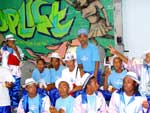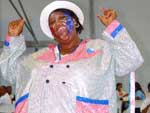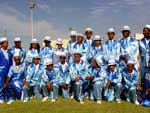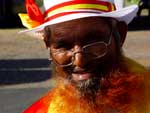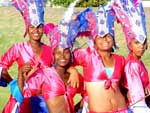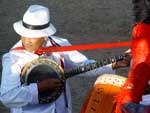A Videographer's
Adventure With Technology
|

|

|
by Andrew Emdon
Owner of Emdon Productions & Musician
As a videographer, (dictionary meaning: video cameraperson & editor) since 1982, I am writing this article purely from my experience of an 'ever changing' technology, from the time I was 13 when I began my hobby of photography.
I've tried to keep tabs of the changes:
As a teenager, I was lucky to have my own good SLR stills
camera & darkroom and took wedding photos for friends &
relatives. In the 70s, videos were non existent. Amateurs and
(professionals) in the function industry, used only celluloid
8mm or super 8mm movies. A clumsy technology involving
electro-mechanical movie cameras, film splicers, viewers &
projectors. Only highly skilled operators could introduce
separate and very delicate sound tracks to their movie films.
Processing and physical splicing many small 50 feet reels was
pains -taking & expensive. The film speed was slow and required
a lot of illumination for an acceptable image, especially for
indoors.
Then in 1982 by chance, I changed from a freelance
photographer to a videographer when a friend bought probably
the earliest type of camera on the market, which comprised of a
separate portable recorder connected by a thick wire to a
gigantic camera which was 60 lux. He was daunted by the camera
and did not want to pursue this hobby so allowed me to take
over the installments of the equipment. Unlimited filming with
instant sound and picture was unheard of then, so it was a
great break through for a new business venture and I was one of
the first in Cape Town to video weddings. I have had a love
hate relationship with this technology ever since.
Here are the changes of video equipment from then till now (comprising 25 years):
- Early 80s: Slow, large, tube cameras used with either Beta or VHS portable recorders. My second camera was a white JVC with a built-in titling generator; the pictures on first generation were superb even at that time!
- Mid Eighties: Appeared big VHS camcorders and Super VHS tapes and camcorders which had improved picture quality with more horizontal lines (I personally saw little difference in the technology) Vision mixers, editing desks and titling devices became more affordable and improved the end product. Charged Couple Computer (CCDs) devices became the picture generators in cameras, replacing cathode camera tubes.
- Early Nineties: Camcorders & tapes became smaller. Different companies brought in their types of technology, Panasonic with the VHS C tape, which fitted into a standard size VHS cassette, the quality was bad, fraught with tracking problems. Sony’s 8mm & Hi8 proved a little superior, but duplicating still remained inferior.
- Late Nineties till now: I call the 'Renaissance' for videographers! 'The Digital Era'. 'Digital' a computer term in this case can be defined as images which are converted to a binary language (computer numerology of 0s & 1s) then converted back to a visual image (on either an adapted camera, or a computer editing system), with no quality loss.
3CCD cameras and mini DV tapes at 550 lines resolution have been the norm for most prosumer
videographers for the last 5 years. Non linear editing allows instant access to any point on the edit line using the appropriate software.
Goodbye to VHS tapes, because DVD discs with chapters and user friendly menus, have taken over.
The Future? High Definition TV & Video. Cameras capable of taking up to 1800 horizontal lines are already available compared to VHS with 270 lines. Special DVDs capable of 50 Gigs storage are soon in the pipeline. With the prevalence of wide screen plasmas and LCD TVs, High def is definitely going to be the norm in the next 5 years for the average household. This means upgrading soon in order to keep up.
The newest professional cameras are using memory sticks storing up to 60 minutes of High definition video. No more tapes or moving parts! The picture quality is as good as any top quality cinema screening. It is like looking at reality!
|
Call For 2007 First Boards Awards
Help Us Find The Industry’s Top Emerging Talent
new directors, agency producers, editors, composers, animators, motion graphic designers and creative teams
|

 |
|
directors:
Entrant can only have been directing commercials for two (2) years or less at entry deadline. Minimum of one (1) sample entered must be a for-hire/commissioned commercial and one (1) sample must have aired by the entry deadline.
editors:
Entrant must have been editing commercials for two (2) years or less at entry deadline. Minimum of one (1) sample entered must be a for-hire/ commissioned commercial and one (1) sample must have aired by the entry deadline. Time spent as editor’s assistant, not included.
creative teams: (Copywriter/Art Director)
Each individual must have only worked in their field within the ad industry for two (2) years or less at entry deadline. Minimum of one (1) sample entered must be a spot that has been broadcast.
*Both members of the team must have worked on all samples entered.
agency producers: new category this year!
Entrant must have been working as a full-up producer at the time of submission and be credited as producer on ALL submitted entries.
composers:
Entrant can only have been composing for commercials for two (2) years or less at entry deadline. Minimum of two (2) of the samples entered must be commercials that have been broadcast.
animators:
Entrant can only have been working in commercial animation for two (2) years or less at entry deadline. Any animation style is acceptable, though minimum of one (1) sample must be a commercial and one (1) must have aired by entry deadline.
motion graphics & broadcast design:
Entrant can only have been working in Motion Graphics or Broadcast Design for two (2) years or less at entry deadline. Samples can be elements from commercials, music videos, titles or promos. At least two (2) samples must have been broadcast.
Entry must include a minimum of two (2) and a maximum of three (3) samples of work, with a total of no longer than five (5) minutes in duration.
Content created for online venues and interactive media can be submitted, as long as the submission fits the criteria set forth in each category and was commissioned and released by an actual client
Please submit reels to:
Sarah Pugsley
Boards Magazine/First Boards Awards
366 Adelaide St. West. #500
Toronto, Ontario, CANADA
M5V 1R9
|
For details click on First Boards Awards logo!
 Printer Friendly Version Printer Friendly Version
Top
|
|
|
Festive Season Campaign 2006 - V&A Waterfront - Clock Tower
|

|
|
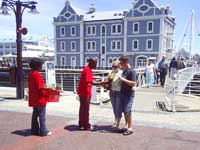
(Pictures: Courtesy of CTRU) |
The first roll out of the Festive Season Campaign 2006 started with a BANG at the V&A Waterfront on Saturday, 2nd December at 11:00. After a short briefing to the “presenters” by Cape Town Routes Unlimited events manager, these presenters went out to welcome visitors at random by offering flowers. Flowers from the Overstrand area in the Overberg region.
The gestures were well received by local and international tourist alike. The Clock Tower was filled with an amazing vibe as the Minstrels were entertaining the crowd sharing a stage with a marimba band from Langa.
More than 1700 flowers were handed out during the campaign with bouquets, attached a flyer informing people about the Information Office at the V&A Waterfront and contact details of the Agulhas Protea Route.
|
|
FRU Salutes And Honours Visionary Pioneer
Richard Ishmail
As We Mourn His Senseless Death
|

|
|
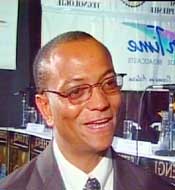
Richard Ishmail
(Picture: Courtesy of SABC News)
|
The Staff, Management and Board of the Film Resource Unit wish to extend our heartfelt condolences to the family, friends, loved ones, and former colleagues of Richard Ishmail who died as a result of brutal stabbing last weekend. The loss of this life is immeasurable in its immensity, to the film, entertainment and media industries, and to all those whose lives he touched and inspired with absolute humility.
The Film Resource Unit has been in existence for 21 years, and ironically, as we prepare to celebrate our ‘coming of age’ with the imminent launch FRU Enterprises Pty.Ltd. - the last element of Ishmail’s vision for the organisation - we mourn his death while celebrating his life. We will salute and honour his extensive contribution all in our celebratory activities.
Richard Ishmail took up a position as coordinator of the Film Resource Unit in 1992. Prior to his entry, FRU had been operating as a community video library collective that disseminated banned and anti-apartheid films. Ishmail quickly transformed FRU from a library into a fully fledged professionally operational distributor through a policy he introduced that respected the right of filmmakers to benefit from the distribution of their works as much as it respected the right of audiences access to them.
Under Ishmail’s leadership FRU phased out its library and proceeded to enter into proper distribution agreements with filmmakers. In April 1993, FRU unveiled its first photocopied catalogue of films for sale. Overnight FRU grew up as its catalogue soon expanded to include the definitive pieces of African -produced films spanning a variety of themes and genres.
A marketing and events magician, Ishmail developed a number of sassy and savvy marketing campaigns and began to exploit the rights of FRU films through video sales to existing community and institutional networks, later to retail and rental markets, and eventually to broadcasters. This was possibly the first time that documentary producers in South Africa could get returns from their rights on intellectual property.
Ishmail pioneered FRU’s move to the Newtown Cultural Precinct, soon to be followed by numerous other cultural NGOs and projects. His work at FRU also catalysed a number of critically important film industry initiatives and shaped the policy landscape that we have today. Most notably, he conceived, birthed and grew Sithengi, a keystone event for our industry which has enshrined its independent operation.
On his exit, Ishmail plotted an expansive vision for FRU, which was successfully implemented by Mike Dearham, this took FRU to heights as a powerful NGO distributing African Films and running immensely successful audience development programmes which continue today, across the country and in the SADC region.
Rest in light and peace Richard, mentor, colleague, boss, brother and friend to so many of us who worked with you. Thank you Richard Ishmail for touching our lives with inspiration and vision. Your ever shining smiles and legacy live on.
|
|
A Curator for Hout Bay’s Museum
|
 |
|
 Jonathan Dreyer (centre), Curator of the Hout Bay Museum with Pitch Black Films
Jonathan Dreyer (centre), Curator of the Hout Bay Museum with Pitch Black Films
|
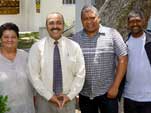
Kathleen Holmes, Gen. Assistant
Jonathan Dreyer, Curator
Kenneth Johannes, Maint. Mngr
Jerome Abrahams, Aux. Services
|
“Understand the past is to appreciate the present”, says the newly appointed Hout Bay Museum curator, Mr. Jonathan (Jonty) Dreyer, “and that is the motto of Hout Bay Museum.”
It was so ironic when this son of Hout Bay soil started to work on his first day as the permanent curator that Pitch Black conducted an interview for an educational programme for SABC 1 to be broadcast on 24 January 2007.
The programme called “What is your story”, deals with those individuals that have contributed positively to the development of Hout Bay and its people.
Jonty, a church, business and community leader, said, “Preserving Hout Bay’s rich history, must depict all sectors and races in Hout Bay, all the people of the Republic of Hout Bay.”
He continues, “it should be transformed and on par with the current political situation in our country.”
For him the museum should educate those not familiar with the country’s history. “Chris Hani, one of the heroes of the struggle against Apartheid, gave his life for the new South Africa and people need to know why.”
“Hout Bay’s rich Khoi (referred to as the Hottentots by the Dutch colonialists) history, the first inhabitants of the area owned Hout Bay. The original name of the area should be researched and the name Hout Bay given by the Dutch colonialist Jan van Riebeeck is not original.”
He also appeals to Government to assist with a process of identifying and declaring Heritage sites such as the original Khoi Cave at the main entrance to the harbour.
He ends with relieve on his appointment, “My role as curator in the community is to make the Hout Bay museum accessible for the whole of Hout Bay and the world.”
|
|
|
by Timothy Jacobs

Timothy Jacobs
with daughter Pashlyn
|
January 1, New Year’s Day, the people of Cape Town and visitors are wished a happy New Year with the magical music sound of the Kaapse Klopse (Cape Town Minstrels). Thousands of people dressed in their satin uniforms and painted faces greet the thousands of people from the rest of South Africa and the world with the wonderful Goema music.
Francisco Jacobs, captain of Hout Bay Entertainers, said, “The carnival is firmly entrenched in the culture and heritage of the Cape Town community. The tradition has its origin when slaves, our forefathers and foremothers, were allowed to relax on Sundays, marched in the streets, played instruments and sang wonderful songs.”
Jacobs continues, “The competition started 99 years ago and the influence of the music has its origin in the African rhythm, Malay slaves and African-American sailors who docked here in the 20th century. It continues every Saturday in January at two different venues.”
The different troupes marche every year on Tweede Nuwejaar (2 January) from Darling Street into Adderley and Wales Streets and end in the Bo-Kaap in Cape Town.
Joseph Cloete, another captain, said, “It is sad that for the last three years we did not have any sponsors and members of the Hout Bay Entertainers joined with the Schotse Kloof Glamour Boys.”
They appeal to businesses for sponsorships to start and enter the Hout Bay Entertainers. A group of 350 persons needs an estimated R120 000 to cover the cost of registration, material, hats, umbrellas, choir and band conductors, singers, venue hiring, transport, the brass band and drum majors.
The group have started a brass band to keep youngsters in Hangberg, Hout Bay away from drugs and crime and an estimated R17 000 is needed to buy the instruments. “We need a good Samaritan to make a difference in the life of our youngsters by donating towards this positive cause”, says Cloete.
The benefit that a business would get is naming and branding rights on stands, umbrellas and display of your banners. They would also be available to do promotional appearances at any activity that the business wishes to present.
It is tradition to have a Klops Table where members are served with refreshments and snacks after a day at the competition and the Glamour Boys thank the following businesses and individuals for their contribution:
South African Breweries, JC Fishing (PTY) Ltd., Johanna Cloete, Dorothy Mathews, Michael Baartman, Jastine Jacobs, Shireen Mathews, Fuad Jacobs, Nadeema Jacobs, Natalie Mathews, Isaac James, David October and Sandra Da Siva.
|
|
| The Controversial Issue Of Alien Organisms
|
|

|
by Patrick Dowling
The issue of alien organisms and their impact on the biodiversity and environmental integrity of host countries is a global concern the specifics of which include loss of indigenous species, erosion, water resource depletion, fire hazards and threats to local economies.
It is the sense of such threats that drive authorities and agencies to actions that can often appear excessive. The clearing of pine and gum trees on the Cape Peninsula is a case in point. Most of these trees started off as smallish plantations to cope with local timber demand and compensate for the earlier denuding of the indigenous forests of Hout Bay and Newlands by colonial decision makers.
Experiencing what is known in conservation circles as ecological release, the absence of natural pests, predators, fungi and diseases that limit nearly all indigenous species on their home turf, the plantations soon started producing many escapees that spread into areas where they had not been planted. Vigorous growers using major supplies of scarce water and crowding out the mountain fynbos these trees, complemented by their invasive acacia fellowa, Rooikrans and Port Jackson in the lower, sandier coastal regions, these plants soon started taking over large parts of the Cape Town landscape. The same was happening in other parts of South Africa which is now facing the challenge of a total invasive alien plant siege equivalent to the area of Britain some 36 million hectares.
Most of the invasive species including birds, animals, fish, crabs were introduced deliberately or accidentally by people over the last 300 hundred years or so. Very few have been transported by wind and currents to our shores. The rapidity of this influx has meant that there has been no time for gradual ecosystem evolution as is the case with natural global changes and so the little understood threat to biodiversity has been considerable with massive regional variety being steadily replaced with monocultures.
Not all aspects of the aliens species is bad which is what leads to their passionate defence by many. Gums, pines and oaks provide shade and cool, sometimes attractive environments that look green and natural. In our short lifetime perspectives they seem to have been there forever.
Where it could be said authorities like National Parks, Cape nature and local authorities have erred in response to alien invasive control is the apparently ad hoc approach adopted. Suddenly the public sees a bare, ugly area of several hectares where there used to be "lovely trees providing shelter for birds and recreational space for people". This is resented and resisted - a pity when proper communication could have ensured public buy-in, alternative plantings, informative signage, set aside recreational areas and so on.
Nevertheless tackling the threat of invasive species remains a high global environmental priority topped only by climate change and GMOs. People migrations, refugees and squatters, sometimes also referred to as alien invasion, has more to do with politics and economics than the biodiversity challenge.
Patrick Dowling
Planning & Environment portfolios
Kommetjie Ratepayers and Residents' Association (KRRA)
Ph +27 (0) 21 783-2509
Ph +27 (0) 21 701-1397 (w)
cell: +27 (0) 84 966-1249
|
 Printer Friendly Version Printer Friendly Version
Top
|
|
|
 From the editor:
Sitting together with Henry at the Green Point Saturday market, sharing some food, frying under a blue sunny Cape Town sky, “like the Kalahari sun” so Henry says, and generating some good business Henry promised me to deliver another story (eNews November edition: The Hottentots-god) which I was looking forward to.
From the editor:
Sitting together with Henry at the Green Point Saturday market, sharing some food, frying under a blue sunny Cape Town sky, “like the Kalahari sun” so Henry says, and generating some good business Henry promised me to deliver another story (eNews November edition: The Hottentots-god) which I was looking forward to.
Just before the delayed cut-off date of the December/January issue I received this fairytale:
Escape to High Places Our Last Minute Fairytale
by Henry Jansen alias Xam
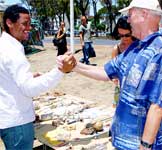
Henry Jansen
and one more happy customer |
Khoikhoin’s child is in search of his father and mother. After he had criss crossed the bush, he could still not find them. He is very confused, deeply depressed and his heart is in pain. He does not want to be an orphan.
Then he meets up with wild buck, but wild buck also knows nothing. He then begins to look further and meets up with guinea fowl, the local gossip channel and who carries all the latest news of the bush around. Don’t you know that they have been eaten up for breakfast? And that you are on the menu for the next night? Be on your merry way, because the lion, elephant and hyena are looking for your blood.
Furious and full of fear he is on his way. All of a sudden the eagle crashes down on him and picks him up in one swoop. Come here Hottentot’s child so that I can take you to safety, high up into the treetops. Come and experience the highest point together with me, until you are strong enough again. “Thank you eagle for being so high up, here they can not get me”, as the mist of the morning disappears like the smoke before the wind.
"The present state of the bushman facing cultural extinction and social genocide taking his last resort in his knowledge of natural steroids and substances to dwell on high places"
|
|
|
 No. 015-01
No. 015-01
|
This Month Welcome Page
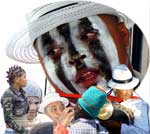
|
FACES OF THE CAPE
Exhibition of Photographs
by
Rudolf Rieger
at
Cape Town Tourism
Crn. Burg and Strand Street
Cape Town
ongoing
 Exhibition Exhibition

CAPE TOWN
Art Workshop @ The Castle Of Good Hopee
|
|
Distribution:
Our e-News are distributed to arts & culture, the film, stills & commercial industry, wildlife, heritage, companies servicing and attracting tourism ( tourist offices, travel agents, tourist guides & tour operators) locally and abroad as well as to people who have an interest in visiting South Africa.
Published by

To ADVERTISE in this Newsletter
 news@onsetimages.com or call 021 790-2227 news@onsetimages.com or call 021 790-2227
Alternatively send us your CONTACT INFORMATION
Print Newsletter (note: set to landscape format) 
|

|
|



















